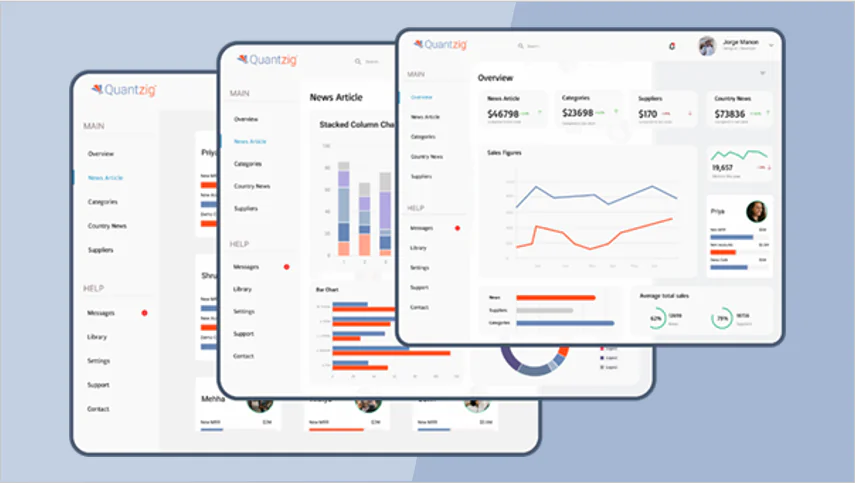Table of Contents
Overview of Electronic Manufacturing Services:
The electronic manufacturing services industry is undergoing a significant transformation, driven by artificial intelligence (AI) and predictive analytics. With the increasing complexity of supply chains, rising production costs, and demand for high-quality electronic products, manufacturers are turning to AI-driven predictive analytics to enhance efficiency, minimize risks, and improve overall yield rates.
This blog explores how AI, IoT, and predictive analytics are revolutionizing electronics manufacturing services (EMS), along with key trends, benefits, and how Quantzig’s advanced analytics solutions can drive data-driven process optimization.
Book a demo to experience the meaningful insights we derive from data through our analytical tools and platform capabilities.
Request a DemoThe Role of AI and Predictive Analytics in Electronics Manufacturing Services
AI and predictive analytics are reshaping the electronics manufacturing services industry by addressing critical challenges such as quality control, equipment downtime, and production inefficiencies. By leveraging machine learning, real-time data analytics, and automation, EMS providers can ensure greater precision, improved cost efficiency, and optimized manufacturing workflows.
1. Enhancing Quality Control with AI
Quality control is crucial in EMS to ensure defect-free products. AI-powered systems use computer vision, machine learning (ML), and real-time monitoring to detect defects and inconsistencies during production.
How AI Improves Quality Control:
- Automated Defect Detection: AI-driven computer vision systems analyze images of PCBs and components to detect microscopic defects with high accuracy.
- Real-time Anomaly Detection: Sensors powered by IoT and AI can instantly detect temperature fluctuations, alignment errors, or soldering issues, ensuring better product quality.
- Predictive Quality Assurance: AI algorithms analyze historical defect data to predict potential quality failures, allowing manufacturers to take preventive measures.
- Automated Rework Analysis: AI can help prioritize and streamline rework processes, ensuring defective products are corrected with minimal waste.
2. Reducing Downtime with Predictive Maintenance
Unplanned equipment failures lead to production downtime, increased costs, and supply chain disruptions. Predictive maintenance leverages AI to forecast machinery breakdowns and schedule maintenance proactively.
How Predictive Maintenance Benefits EMS:
- Sensor-Based Monitoring: IoT-enabled sensors track machine vibrations, temperature, and pressure in real time.
- AI-Driven Failure Prediction: ML models analyze machine data to predict failures before they occur, reducing unexpected downtime.
- Optimized Maintenance Scheduling: AI helps schedule maintenance during non-peak hours, maximizing equipment availability and minimizing disruptions.
- Spare Parts Optimization: AI-driven inventory analysis ensures that the right spare parts are available when needed, reducing costly emergency repairs.
3. Improving Yield Rates with AI-Driven Process Optimization
Yield rate optimization is essential in EMS to maximize production efficiency and minimize material wastage. AI-powered process control ensures optimal production parameters, leading to higher yields.
AI’s Role in Yield Improvement:
- Automated Process Adjustments: AI dynamically adjusts temperature, pressure, and speed in real time for optimal output.
- Material Waste Reduction: Predictive analytics identifies inefficiencies in material usage, reducing scrap rates.
- Real-Time Performance Monitoring: AI-driven dashboards provide real-time visibility into production performance, enabling quick decision-making.
- Batch Production Optimization: AI-driven insights help determine the best batch sizes and sequences to minimize defects and maximize throughput.
Emerging Trends in AI and Predictive Analytics for Electronic Manufacturing Services
The integration of AI and predictive analytics is rapidly evolving. Below are some key trends shaping the future of the electronics manufacturing services industry:
| Trend | Description |
|---|---|
| AI-Driven Robotics | Advanced AI-powered robots enhance assembly line automation, reducing human errors. |
| Digital Twin Technology | AI creates digital replicas of manufacturing processes to simulate and optimize production. |
| Edge AI for Real-Time Processing | AI algorithms embedded in IoT devices enable instant decision-making without cloud dependency. |
| Self-Learning AI Systems | AI models continuously learn from new data, improving process efficiency and adaptability. |
| Blockchain for Quality Control | AI-integrated blockchain ensures tamper-proof quality assurance in supply chains. |
| AI-Powered Supply Chain Visibility | Predictive analytics enhances demand forecasting, inventory management, and supplier collaboration. |
Experience the advantages firsthand by testing a customized complimentary pilot designed to address your specific requirements. Pilot studies are non-committal in nature.
Request a pilot
Why the Electronics Manufacturing Services Industry Needs AI-Driven Analytics
The electronic manufacturing services industry faces intense competition, fluctuating demand, and increasing regulatory requirements. AI-driven analytics solutions help manufacturers:
- Increase operational efficiency by automating manual tasks.
- Enhance product quality by reducing defects and process deviations.
- Optimize supply chain management with real-time visibility.
- Reduce costs by minimizing equipment downtime and material waste.
- Ensure compliance with industry regulations through data-driven quality checks.
- Improve workforce productivity by automating repetitive and labor-intensive tasks.
- Enable sustainability initiatives by reducing material waste and energy consumption.
How Quantzig Enables Data-Driven Process Optimization in EMS
Quantzig specializes in AI-driven analytics solutions designed to help electronics manufacturers unlock new opportunities for growth. Our expertise in predictive analytics, IoT integration, and AI-based process optimization enables companies to:
- Improve Production Efficiency: Advanced AI models optimize workflows, reduce waste, and enhance productivity.
- Enhance Supply Chain Resilience: Real-time analytics improve demand forecasting, supplier management, and logistics planning.
- Minimize Equipment Failures: Predictive maintenance ensures maximum uptime, reducing unplanned shutdowns.
- Increase Quality Control Accuracy: AI-powered quality monitoring lowers defect rates and improves compliance.
- Enable Smart Decision-Making: AI dashboards provide actionable insights to drive strategic decisions.
- Enhance Customization Capabilities: AI-driven production insights allow manufacturers to efficiently produce customized electronic components.
The Future of AI in Electronics Manufacturing
The electronics manufacturing services industry is set to witness further AI-driven advancements. In the coming years, AI will drive hyper-automation, self-healing systems, and AI-powered supply chain networks, enabling seamless and intelligent manufacturing.
Future Developments in AI for EMS:
- AI-Driven Autonomous Production Lines: Fully automated production lines with AI-powered robots that self-optimize manufacturing parameters.
- Advanced Predictive Models for Supply Chain Disruptions: AI will provide real-time alerts and alternative solutions for supply chain bottlenecks.
- AI-Enhanced Energy Management: AI will optimize energy usage in manufacturing plants to reduce costs and carbon footprints.
Conclusion: Transform Your EMS Operations with Quantzig
AI and predictive analytics are no longer optional in electronics manufacturing services—they are essential for achieving higher efficiency, lower costs, and superior product quality. As a leader in AI-driven analytics, Quantzig empowers EMS providers with real-time insights, predictive capabilities, and automation solutions to stay ahead of the competition.

Ready to unlock the full potential of AI in your electronics manufacturing process?
Start your trial



